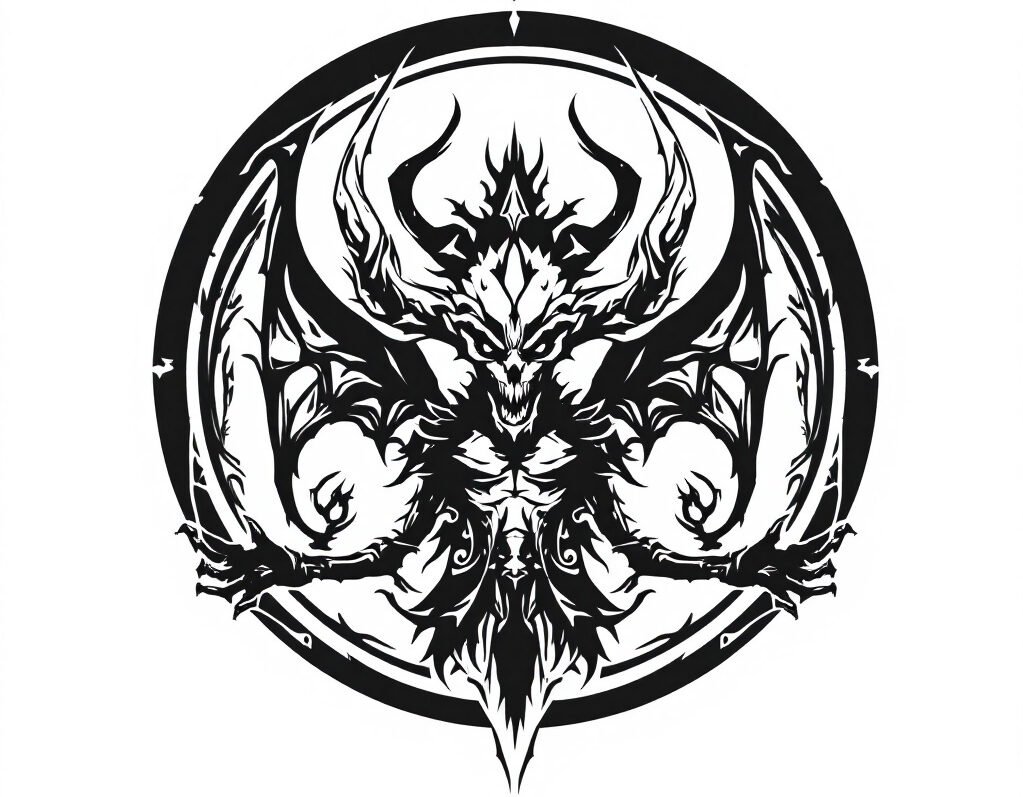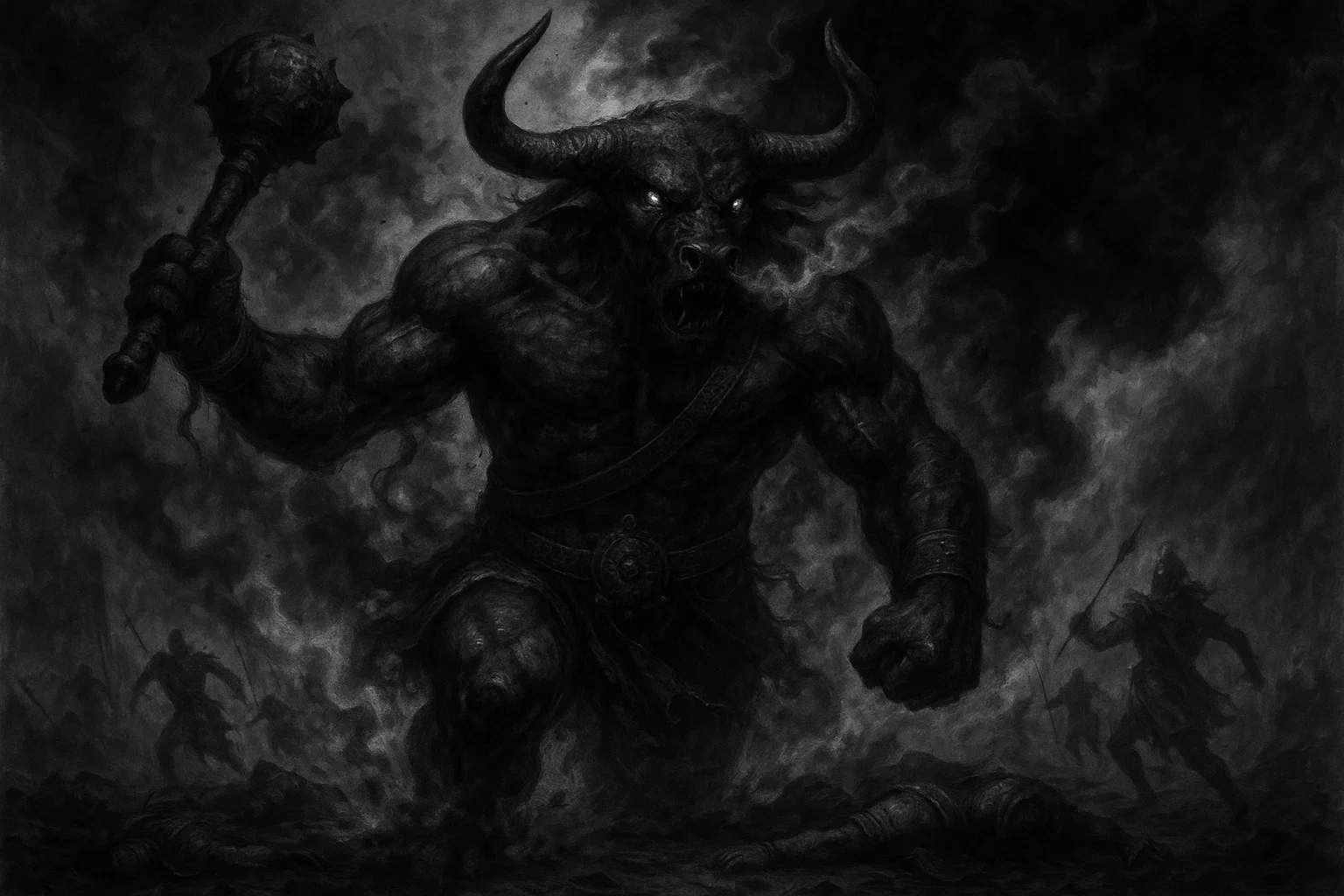Mahishasura, a formidable Asura in Hindu mythology, is best known as the buffalo demon defeated by Goddess Durga during the festival of Navratri.
As a prominent Daitya leader, his story in the Devi Mahatmya (part of the Markandeya Purana) highlights his immense power and eventual downfall, symbolizing the triumph of good over evil. His name, combining “Mahisha” (buffalo) and “Asura” (demon), reflects his shape-shifting nature and fierce dominance over the three worlds—earth, heaven, and the netherworld—before his defeat.
His story begins with his rise to power through a boon from Brahma, which granted him near-invincibility, and ends with his defeat by Durga, created by the collective energy of the gods. While Mahishasura is portrayed as a villain in these texts, his complex character is characterized by strength, cunning, and devotion.
Summary
Key Takeaways
| Attribute | Details |
|---|---|
| Names | Mahishasura, Mahisha |
| Title | King of Asuras, Daitya Leader |
| Gender | Male |
| Role | Conqueror, Antagonist to Devas, Symbol of Chaos |
| Clan | Daitya |
| Followers | Asuras, Demonic Armies |
| Powers | Shape-shifting, Immense Strength, Near-Invincibility (Boon from Brahma) |
| Appearance | Half-Man, Half-Buffalo; Often Horned, Muscular, with a Fierce Visage |
| Etymology | Mahisha (buffalo), Asura (demon); “Buffalo Demon” in Sanskrit |
| Associated Figures | Durga, Brahma, Devas, Rambha, Karambha |
| Weaknesses | Vulnerable to Durga’s Divine Power, Overconfidence |
| Opposing Deva/Avatar | Goddess Durga |
| Pantheon | Hindu, with Puranic Influences |
| Primary Sources | Devi Mahatmya, Markandeya Purana, Devi Bhagavata Purana |
Mahishasura Meaning
The name Mahishasura carries deep linguistic and cultural significance in Hindu mythology. Derived from Sanskrit, the Mahishasura definition breaks into two parts: “Mahisha,” meaning buffalo, and “Asura,” meaning demon or anti-god. Together, Mahishasura’s meaning translates to “Buffalo Demon,” a fitting title for a shape-shifting Daitya who embodies raw power and chaos.
The buffalo, a symbol of strength and stubbornness in Indian culture, likely suggests the unyielding ambition to dominate the three worlds. His name appears consistently in Devi Mahatmya and Devi Bhagavata Purana, with no major variations, emphasizing his singular identity as a formidable foe.
The etymology of Mahishasura ties to Vedic and Puranic traditions, where animals often symbolize specific traits. The buffalo, linked to earth and brute force, contrasts with the divine grace of Goddess Durga, his slayer. Some scholars even suggested that “Mahisha” could also evoke fertility and primal energy, hinting at his complex role beyond mere villainy.
In regional folklore, particularly in South India, his name is sometimes shortened to Mahisha. For example, in Karnataka, the city of Mysuru (formerly Mysore) is mythically tied to Mahishasura, believed to be his domain.
How To Pronounce Mahishasura in English
Mahishasura is pronounced in English as “Muh-hee-shuh-soo-ruh.” Break it down as: “Muh” (like “mud”), “hee” (like “he”), “shuh” (like “shoe”), “soo” (like “soup”), and “ruh” (like “run”). The emphasis is on the second syllable, “hee.”
What Does Mahishasura Look Like?
Mahishasura is typically depicted as a fearsome figure, blending human and buffalo traits. The Devi Mahatmya describes him as a tall, muscular being with a dark, horned buffalo head, sharp teeth, and glowing eyes that radiate menace. His human form, often utilized through shape-shifting, is equally imposing—broad-chested, clad in armor, and wielding weapons such as a mace or sword.
In temple art (such as at Ellora or Mahabalipuram), he appears mid-transformation, with the bulk of a buffalo and the stance of a warrior, emphasizing his duality. His dark skin, sometimes blue or black, symbolizes his demonic nature, while his muscular build reflects his immense strength.
During battle with Durga, he shifts forms—lion, elephant, or buffalo—to evade her, showcasing his cunning.
Origins
Mahishasura is a central figure in Hindu mythology, as mentioned in the Devi Mahatmya, a key text within the Markandeya Purana (circa 5th–6th century CE). His story likely draws from earlier Vedic themes of cosmic battles between gods and demons, although his specific narrative takes shape within the context of Puranic literature.
As a Daitya, he descends from the lineage of Diti—the mother of all demons—and his rise to power reflects the eternal struggle between Devas and Asuras. His earliest documented appearance is in the Devi Mahatmya, where he conquers the heavens after receiving a boon from Brahma, making him nearly invincible. Over time, his tale spread through oral traditions and regional folklore, particularly in South India, where he is linked to Mysuru’s cultural history.
Later, his narrative evolved into a symbol of chaos versus order, celebrated during Navratri festivals. In later texts (such as the Devi Bhagavata Purana), his story gains additional details, including his battles with Indra and his eventual slaying by Durga.
You may also enjoy:
Agubanba: The Ash-Born Demon of Japanese Folklore
October 23, 2025
Who Are the Yaksha, and Why Did Buddhists Fear Their Wrath?
October 20, 2025
Who Is Aka Manto, Japan’s Terrifying Red-Cloaked Yōkai?
October 24, 2025
Who Is Jann in Islamic Mythology and Why Is He Feared?
October 2, 2025
Palden Lhamo: The Black Goddess of Blood and Protection
October 20, 2025
Who Was Hiranyakashipu, the Demon King of Hindu Mythology?
October 6, 2025
Birth
According to the Devi Mahatmya and Devi Bhagavata Purana, Mahishasura was born to Rambha (a Daitya king) and a buffalo princess. His father, Rambha, and uncle, Karambha, were sons of Diti and the sage Kashyapa, placing Mahishasura in the Daitya lineage.
The Kalika Purana describes how Rambha, enamored by a water buffalo, married her, and their union produced Mahishasura, whose half-buffalo form stemmed from his mother’s lineage.
Born in a time of cosmic turmoil, he grew up with immense strength and ambition, having been trained in both warfare and magic. His early life, though sparsely detailed, focused on his rise as a Daitya leader, driven by a desire to challenge the Devas.
Family
Mahishasura’s family ties are rooted in the Daitya lineage, with his father, Rambha, and mother, a buffalo princess, shaping his dual nature.
His paternal grandfather, Kashyapa (a revered sage), and grandmother, Diti (mother of Daityas), link him to the broader demonic clan opposing the Devas. His uncle, Karambha, was a Daitya warrior killed by Indra, fueling Mahishasura’s hatred for the gods.
The Devi Mahatmya does not mention siblings, a spouse, or children, suggesting he stood alone as a leader. His family dynamics, centered on Rambha’s ambition and Diti’s legacy, drove his quest for power, with no recorded alliances softening his fierce independence.
| Genealogy | Details |
|---|---|
| Parents | Rambha (father), Buffalo Princess (mother) |
| Siblings | None |
| Spouse | None |
| Children | None |
Asura-Deva Conflicts
According to the Devi Mahatmya, Mahishasura plays a significant role in the cosmic struggle between the Asuras and the Devas.
After receiving a boon from Brahma that no man or god could kill him, he launched a brutal campaign, defeating Indra and seizing the heavens. His armies of Asuras terrorized the three worlds, disrupting dharma and challenging divine authority. The Devas, unable to beat him, pooled their energies to create Goddess Durga, who engaged Mahishasura in a fierce nine-day battle.
His shape-shifting—into a lion, an elephant, and a buffalo—failed against Durga’s divine power, and she slew him with her trident, thereby restoring cosmic order.
Role in Hindu Cosmology
Mahishasura embodies the disruptive force of adharma (disorder) in Hindu cosmology, challenging the balance of creation, preservation, and destruction.
In the Devi Mahatmya, he is a clear villain, his conquests threatening the gods and the natural order. Yet, his story also highlights the necessity of divine intervention, as Durga’s creation reflects the gods’ collective effort to restore dharma. His defeat signifies the cyclical nature of good overcoming evil, a theme central to Navratri celebrations.
Unlike the benevolent Asura Prahlada, Mahishasura‘s ambition lacks devotion, making him a cautionary figure against unchecked power.
However, even today, his influence extends to human affairs through festivals, where his effigies are burned, symbolizing the destruction of ego and chaos, and reinforcing the triumph of dharma in both divine and mortal realms.
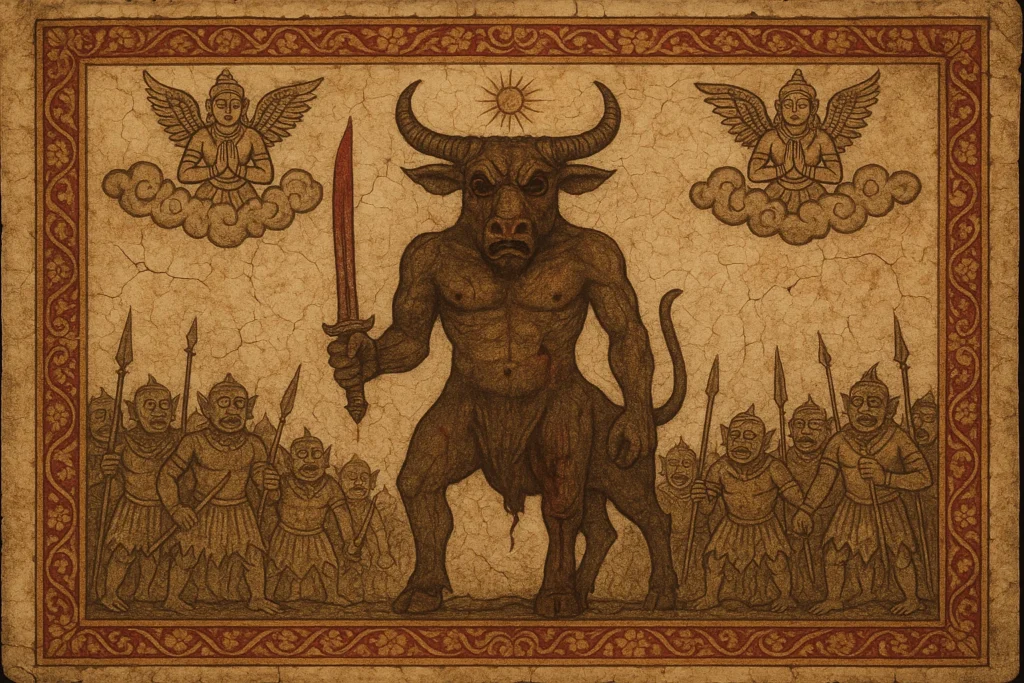
Was Mahishasura Ever Mentioned in Vedic Texts?
Mahishasura does not appear in early Vedic texts. His narrative likely originated in later Puranic traditions, particularly the Devi Mahatmya (5th–6th century CE), as the worship of Goddess Durga gained prominence.
The Vedic period focused on deities like Indra battling generic demons (Rakshasas or Asuras), but there is no specific reference to Mahishasura.
Mahishasura in Epics and Puranas
The demon’s primary appearances are in the Devi Mahatmya (part of the Markandeya Purana, attributed to sage Markandeya) and the Devi Bhagavata Purana.
In the Devi Mahatmya, he is the central antagonist, a Daitya who conquers the heavens and is defeated by Durga in a nine-day battle. The Devi Bhagavata Purana elaborates on his birth and powers, calling him “the mighty buffalo demon.” His epithets include “King of Asuras” and “Mahisha.”
He does not appear in the Ramayana or Mahabharata, as his story is tied to Shakta traditions.
| Source | Quote |
|---|---|
| Devi Mahatmya 2.11 | “Mahishasura, the great Asura, ruled with might, oppressing the gods.” |
| Devi Bhagavata Purana 5.2 | “Born of Rambha and a buffalo, Mahishasura shook the three worlds.” |
Powers and Abilities
The best description of this Asura’s powers is found in the Devi Mahatmya and the Devi Bhagavata Purana. In these texts, he is a formidable foe:
- Shape-Shifting: Transformed into a buffalo, lion, or elephant during battle to evade Durga.
- Immense Strength: Overpowered Indra and the Devas, conquering the heavens.
- Near-Invincibility: A boon from Brahma ensured no man or god could kill him, leaving him vulnerable only to a goddess.
- Military Leadership: Commanded vast Asura armies, dominating the three worlds.
- Magical Prowess: Used illusion and sorcery to confuse enemies in combat.
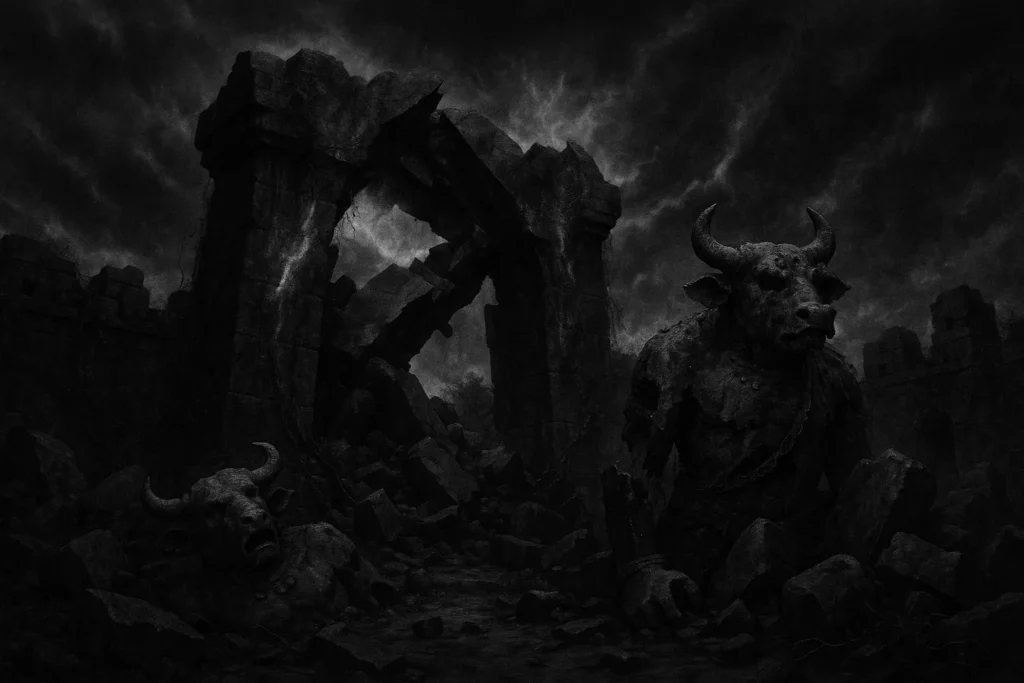
Mahishasura Myths, Legends, and Stories
Conquest of the Heavens (Devi Mahatmya)
In the Devi Mahatmya (Chapter 2), Mahishasura, born of Rambha and a buffalo princess, grew into a mighty Daitya. Seeking dominion, he performed intense penance to please Brahma, who granted him a boon: no man or god could kill him.
Emboldened, Mahishasura gathered his Asura armies and attacked the heavens. He defeated Indra, king of the Devas, and drove the gods out, seizing their realms. The gods, distressed, approached Brahma, Vishnu, and Shiva. Their combined energies gave birth to Goddess Durga, radiant and armed with divine weapons.
Mahishasura, unaware of her power, mocked her as a mere woman. Their battle raged for nine days, with Mahishasura shifting forms—buffalo, lion, elephant—to escape her. On the tenth day, Durga pierced his heart with her trident, slaying him as he emerged in human form, restoring the heavens to the Devas.
You may also enjoy:
Banasura: The Thousand-Armed Demon King
October 10, 2025
Rāga: The Seductive Demon of Passion and Desire in Buddhist Lore
October 16, 2025
What Is the Abumi-guchi Yōkai and Why Does It Wait Forever?
October 22, 2025
Bali: The Benevolent Asura King of Hindu Mythology
October 10, 2025
Mahakala: The Dark Guardian Who Consumes Evil
October 16, 2025
Who Is Taṇhā, the Seductive Demon of Craving in Buddhist Mythology?
October 15, 2025
Mahishasura’s Birth and Rise (Devi Bhagavata Purana)
The Devi Bhagavata Purana (Book 5) details the origins of Mahishasura. Rambha, a Daitya king, fell in love with a buffalo princess during his travels. Their union produced Mahishasura, a half-buffalo, half-human demon of immense strength.
Raised among Asuras, he honed his skills in warfare and magic. After Indra killed his uncle Karambha, Mahishasura vowed revenge. He performed tapasya (penance) for years, pleasing Brahma, who granted him near-invincibility. With this boon, he amassed an army and overthrew the Devas, ruling the three worlds.
His arrogance grew, believing none could challenge him, until Durga emerged. His defeat, after a fierce battle, marked the restoration of divine order, celebrated annually during Navratri.
Mahishasura vs Other Asuras
| Asura Name | Associated Trait/Role | Clan/Origin | Key Traits/Powers |
|---|---|---|---|
| Ravana | Conquest | Rakshasa, Ramayana | Boons, Shape-Shifting, Ten Heads |
| Hiranyakashipu | Tyranny | Daitya, Bhagavata Purana | Invincibility Boon, Illusion |
| Hiranyaksha | Earth’s Abductor | Daitya, Vishnu Purana | Strength, Boons |
| Bali | Sacrifice | Daitya, Bhagavata Purana | Generosity, Immortality |
| Vritra | Drought | Asura, Rig Veda | Serpent Form, Water Control |
| Narakasura | Oppressor of Women | Asura, Mahabharata | Illusion, Military Power |
| Tarakasura | Warlord | Daitya, Skanda Purana | Invincibility Boon |
| Andhaka | Blind Conqueror | Asura, Shiva Purana | Regeneration, Strength |
| Bhasmasura | Self-Destruction | Asura, Shiva Purana | Ash-Touch Boon |
| Shumbha | Co-Ruler | Asura, Devi Mahatmya | Combat, Leadership |
| Nishumbha | Co-Ruler | Asura, Devi Mahatmya | Combat, Sorcery |
| Raktabija | Blood Replication | Asura, Devi Mahatmya | Blood-Based Regeneration |
| Bana | Thousand-Armed Warrior | Asura, Shiva Purana | Multiple Arms, Strength |
| Kumbhakarna | Slumbering Giant | Rakshasa, Ramayana | Gigantic Size, Strength |
| Vibhishana | Devotee | Rakshasa, Ramayana | Loyalty to Rama, Wisdom |
Rank Among Asuras
Mahishasura holds a prominent place among the Daityas, rivaling figures like Ravana and Hiranyakashipu in terms of power and infamy. As the King of Asuras in the Devi Mahatmya, he led vast demonic armies, conquering the heavens and challenging Indra.
His near-invincibility (granted by Brahma) set him apart, as did his ability to shape-shift, a rare skill among Asuras. Unlike Ravana (a scholar-king) or Bali (a benevolent ruler), Mahishasura’s ambition was purely destructive, making him a feared leader.
His rivalry with the Devas, especially Indra, and his defeat by Durga cemented his status as a symbol of chaos. Among the Asuras, such as Shumbha and Nishumbha, whom Durga also defeated, Mahishasura stands out for his solo dominance.
Mystical Correspondences
| Attribute | Details |
|---|---|
| Planet | Mars |
| Zodiac Sign | Aries |
| Element | Fire |
| Direction | East |
| Color | Red |
| Number | 9 |
| Crystal/Mineral | Garnet |
| Metal | Iron |
| Herb/Plant | Red Sandalwood |
| Animal | Buffalo |
| Trait/Role | Conquest, Chaos |
Mahishasura’s cosmic ties anchor his destructive energy in the heavens, with Mars as his ruling planet, embodying war and aggression. Mars fuels his conquests, as seen in his defeat of Indra, through rituals that often invoke his strength, frequently tied to Mars’s influence, such as Tuesdays or the Aries season (March 21–April 19).
His zodiac sign, Aries, channels fiery ambition, driving his relentless pursuit of power. This alignment enhances his martial prowess, as depicted in the Devi Mahatmya, where his armies storm the heavens.
His fire element reflects his burning ambition and destructive might, evident in his fiery battles with Durga.
The east, the direction of sunrise in Vedic cosmology, ties to his dominion, as his power radiated from his earthly stronghold.
Red, his symbolic color, mirrors his ferocity and bloodshed, while the number 9 connects to the nine days of Navratri, marking his defeat.
Garnet and iron symbolize his strength and resilience, used in rituals to channel his energy.
Red sandalwood and the buffalo further ground his identity, linking his primal force to both nature and destruction, defining his role as a chaotic conqueror.
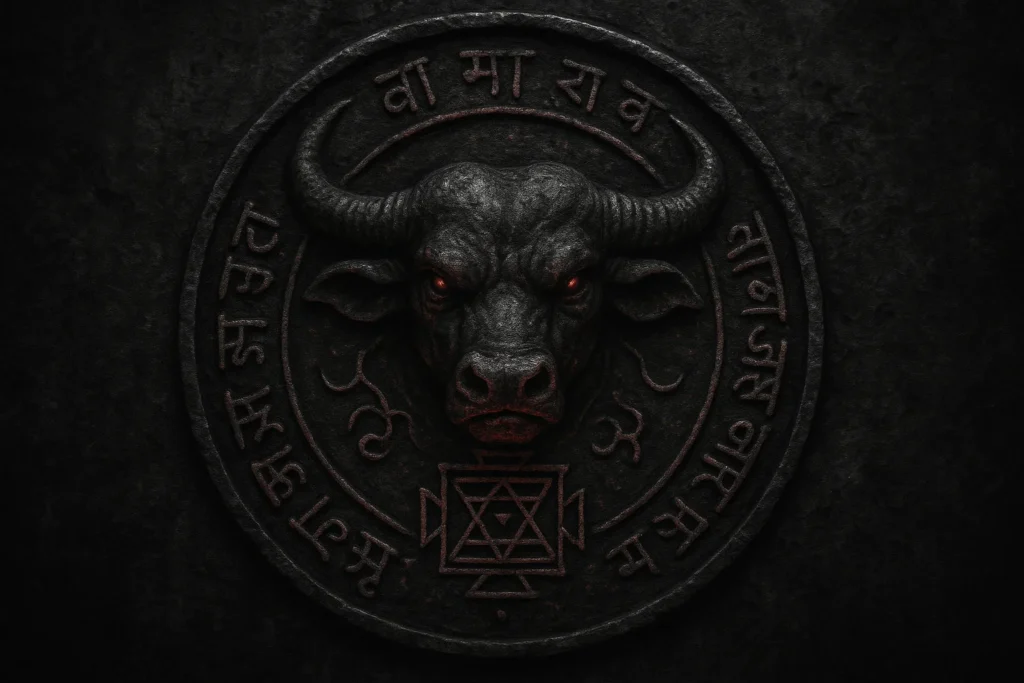
Mahishasura’s Symbols
Mahishasura is associated with symbols reflecting his power and nature. The buffalo head, prominent in temple art, represents his brute strength and earthly dominance. His mace, often depicted in carvings, symbolizes his martial prowess, while his horned visage signifies his demonic authority.
In Shakta traditions, yantras (geometric diagrams) used in Durga worship sometimes depict Mahishasura’s defeat, with his image at the center, symbolizing the subjugation of chaos.
Worship and Boons
Mahishasura’s power stemmed from intense tapasya (penance) that pleased Brahma, as described in the Devi Mahatmya. He meditated for years, enduring harsh austerities, until Brahma granted him a boon: no man or god could kill him.
This near-invincibility allowed him to conquer the heavens, defeating Indra and the Devas. His worship, though rare, is found in some tantric traditions, where practitioners invoke his strength for protection or power, utilizing red sandalwood and buffalo imagery in rituals.
However, his defeat by Durga led to her worship during Navratri, where effigies of Mahishasura are burned, symbolizing the destruction of evil. The Devas, distressed by his tyranny, sought Brahma, Vishnu, and Shiva, who created Durga to counter his boon, as it did not protect against a goddess.
You may also enjoy:
Mahakala: The Dark Guardian Who Consumes Evil
October 16, 2025
Marid: The Ocean Jinn That Defies Heaven and Earth
September 30, 2025
Aamon: The Infernal Marquis of Lust, Feuds, and False Prophecies
September 29, 2025
Who Was Mahishasura, the Buffalo Demon Slain by Goddess Durga?
October 3, 2025
Agubanba: The Ash-Born Demon of Japanese Folklore
October 23, 2025
Palden Lhamo: The Black Goddess of Blood and Protection
October 20, 2025
